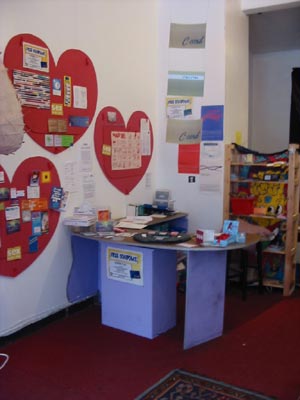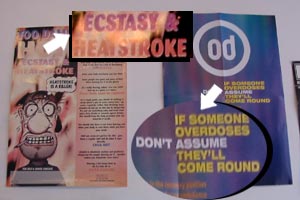"Just
Say No." —Nancy Reagan
"Users
are Losers." —McGruff the Crime Dog
"I
chose not to choose life: I chose something else. And the reasons?
There are no reasons. Who need reasons when you've got heroin?"
—Trainspotting
 On
Cockburn Street in the medieval city of Edinburgh, behind a brightly
spray-painted store façade sandwiched in between a record
shop and a bookstore, can be found a solution to some very modern
problems. Adopting "Know the Score" as its motto, Crew
2000 began in 1991 as a grassroots movement started by an eclectic
group of dance-party organizers, club goers, activists, and health
professionals. In the words of the organization's
Web site, the organization neither "condone[s] or
condemn [s] drug use but. . . recognize[s] that it is widespread
and that there are steps that can be taken to reduce any potential
harm." In the United States, harm-reduction is a somewhat controversial
position; in the UK, Crew 2000 and other organizations have been
making it work for over a decade.
On
Cockburn Street in the medieval city of Edinburgh, behind a brightly
spray-painted store façade sandwiched in between a record
shop and a bookstore, can be found a solution to some very modern
problems. Adopting "Know the Score" as its motto, Crew
2000 began in 1991 as a grassroots movement started by an eclectic
group of dance-party organizers, club goers, activists, and health
professionals. In the words of the organization's
Web site, the organization neither "condone[s] or
condemn [s] drug use but. . . recognize[s] that it is widespread
and that there are steps that can be taken to reduce any potential
harm." In the United States, harm-reduction is a somewhat controversial
position; in the UK, Crew 2000 and other organizations have been
making it work for over a decade.
Much
as with its sister organization in the U.S., DanceSafe,
the Crew 2000 credo revolves around street-level education. Just
as the 21-and-over drinking age in the U.S. has led to an increase
in binge drinking on college campuses and elsewhere, abstinence-only
education glamorizes the forbidden activity while simultaneously
stigmatizing it and preventing the dissemination of helpful facts.
"The pitfalls of abstinence-only education is that you exclude
people who have chosen to use," said a Crew 2000 staff member,
who asked to remain anonymous. "You have no right to tell people
what to do with their bodies."
Crew
2000 is funded by a combination of private charities, government
grants, and selling training services to those organizations that
can pay (other training is done on a pro-bono basis). Its board
of directors is composed both of professional administrators and
social workers and actual volunteers and staff members with the
street experience to know what works and what does not in the realm
of sex and drug education. Most Crew 2000 volunteers and staff,
according to the members we spoke to, also are or were drug users.
(And, so far as their sex-education efforts go, we can assume that
few are virgins.)
It is
this ear to the ground that makes Crew 2000 such a success: Underground
subcultures are notoriously volatile. Tastes in music, clothes,
identities, and drugs change constantly. By the time they're found
out by the mainstream and either marketed and exploited or legislated
against, they've mutated into new forms. Crew 2000 has the knowledge
of these subcultures, and the credibility to both be listened to
both accurately track drug use, and to take their harm-reduction
philosophy to the streets and clubs. Thus far, they have been remarkably
successful.
 The
philosophy of harm reduction recognizes that people are not angels,
and that some will choose to participate in particularly pleasurable
activities such as taking Ecstasy, dancing all night, and then going
home and screwing. While not actively promotiong such activities,
it is possible to help people stay safe. For instance, with a "C-card,"
teenagers can stop in and pick up free condoms. Crew 2000 also offers
drug-testing kits, so that Ecstasy pills can be checked for adulterants.
(The risk of harmful contaminants is, of course, one of the major
dangers of an underground drug market.) Their goal, in short, is
to both provide information so that people who participate in risky
activities can do so in the safest way possible, while those who
do develop health problems of one kind or another can get the help
they need. The posters at the right, for instance, tell readers
what to do if someone ODs, and how to avoid heatstroke while dancing
on Ecstasy.
The
philosophy of harm reduction recognizes that people are not angels,
and that some will choose to participate in particularly pleasurable
activities such as taking Ecstasy, dancing all night, and then going
home and screwing. While not actively promotiong such activities,
it is possible to help people stay safe. For instance, with a "C-card,"
teenagers can stop in and pick up free condoms. Crew 2000 also offers
drug-testing kits, so that Ecstasy pills can be checked for adulterants.
(The risk of harmful contaminants is, of course, one of the major
dangers of an underground drug market.) Their goal, in short, is
to both provide information so that people who participate in risky
activities can do so in the safest way possible, while those who
do develop health problems of one kind or another can get the help
they need. The posters at the right, for instance, tell readers
what to do if someone ODs, and how to avoid heatstroke while dancing
on Ecstasy.
As another
example, one Crew 2000 sex-ed informational card takes the official
U.S. government stance on abstinence-only education, smacks it around,
runs its underwear up the flagpole-and, in the process, probably
saves a lot of human suffering. Taking a wholly realistic view of
the fact that, yes, people of all ages do have sex, and written
in the language everyone uses every day, the card enlists the reader's
help in the fight against sexually transmitted diseases:
"Face
it, sex kicks ass!" it reads. "But just because you're
out there fucking doesn't mean you have to get fucked up in the
process. The spread of HIV and AIDS are by no means under control
and it's up to you to take precautions."
In contrast,
the situation that exists in the United States right now has not
changed much since Margaret Sanger's arrest for giving information
on contraception in the early 1900s. In those days, dissemination
of birth control material was illegal because of the Comstock Laws,
yet then, as now, there was a group of men and women who either
financially or physically could not afford to have more children.
The results were high rates of infant mortality and deaths from
complications in childbirth, particularly amongst poor immigrant
women. Yet, people kept on having sex, as they have since we evolved
from the primordial ooze. Expecting teenagers to abstain is not
a realistic strategy; making condoms available to them is.
Another
excellent example of the harm-reduction philosophy, this time as
applied to hard-core drug use, is a book of 30 tear-off cards meant
for heroin users to give to their friends. By targeting, in a realistic
fashion, the way people become addicts, the cards go far beyond
"Just Say No" platitudes in the attempt to prevent further
damage:
"Break
the cycle," read the cards. "You inject but that doesn't
mean you want others to do the same. Without meaning to, that's
exactly what you could be doing by talking about injecting to non-injectors,
injecting in front of non-injectors, [or] giving people their first
hit. Think about whether you really want other people to end up
doing what you're doing."
"Overdose
is now the largest cause of death amongst injecting heroin uses,"
another informational booklet begins. "Many drug users overdose
because they don't realize the risks they are taking when they inject
heroin and use combinations of heroin and other drugs (including
alcohol). Many deaths happen because people who see overdoses don't
know what to do to help. This booklet aims to change that by giving
you information on overdoes risks; methadone and overdose; myths
and things that it is dangerous to do; calling an ambulance; and
first aid for people who have overdosed."
The simple,
non-preaching booklet then goes on to give information that could
have possibly saved thousands of lives of heroin users whose sole
idea of what to do in case of an OD was gained by watching "Pulp
Fiction."
Heroin
addiction, of course, is an extreme and atypical case of drug use.
Despite the traditional stereotype of the junkie, most users only
take drugs occasionally, and the vast majority do not become addicts.
Some, mirable dictu, even find it an enjoyable and mind-expanding
experience. However, that does not mean that recreational drugs
are entirely safe. Harm-reduction seeks to educate potential users
on what they're getting in to:
"Millions
of people have taken MDMA without significant problems," reads
a Crew 2000 informational card on Ecstasy. "This does not,
however, make it completely safe, as several new studies have shown."
The card then gives the results of several leading studies, as well
as practical advice, such as the need to stay hydrated when dancing
on Ecstasy, and the possibilities of getting slipped a dangerous
substitute when one thinks one is buying X.
Finding
straight talk such as this on the dangers and how to enjoy oneself
safely and responsibly, or even finding realistic dialogue on drugs
stripped of fire-and-brimstone absolutes, is quite difficult in
an abolitionist climate. By providing frank information, Crew 2000
does a valuable service. The question is, is this a model for the
direction that drug education should take in America?
The United
States is, in many ways, a nation perpetually fighting the battle
of Armageddon. Our government responds to every social problem-be
it poverty, crime, illiteracy, or of course, drug use-by declaring
a total, unremitting "war" on it. And, just as our battle
plan is derived from the Book of Revelations, so, too is our attitude
towards the casualties: Those who fall by the wayside of our continual
march forward are seen as victims of their own moral failings, deserving
of their fate in the pit of fire and brimstone. Worse, those who
would sue for peace by advocating the reform of the current system,
or who point out the hypocrisy of the hellfire-preachers, are seen
as even more despicable than the sinners, and are reviled as apprentice
Antichrists themselves who betray our war efforts by seducing the
innocent into their own decadent lifestyles.
Thus
far, particularly as the "war on drugs" is concerned,
only two things have been served by the current rhetoric: the status
quo, and the self-righteousness of the moralists. Yet, America is
just one nation, albeit an influential one, in a very big world.
We should recognize that other people in other places seek a more
pragmatic approach to social ills, one that balances the realities
of human nature with the greater good—and,
in a losing war, one should consider all alternatives to utter defeat.